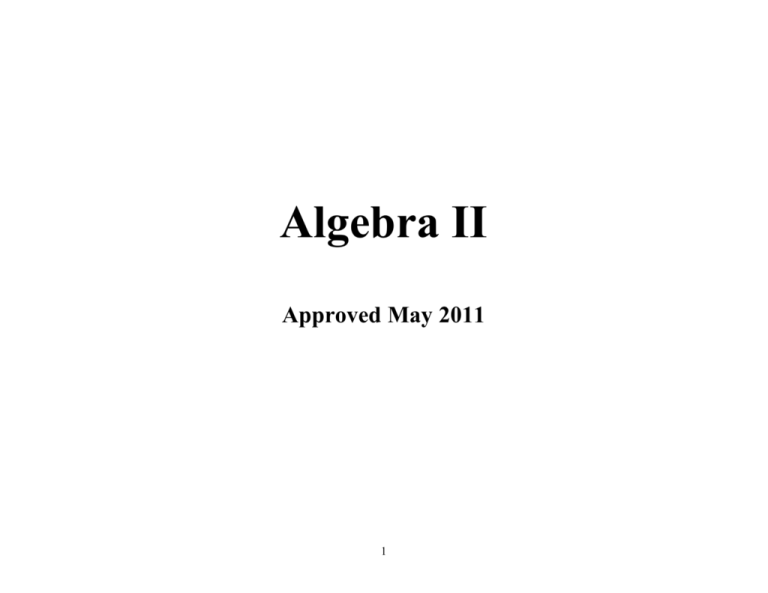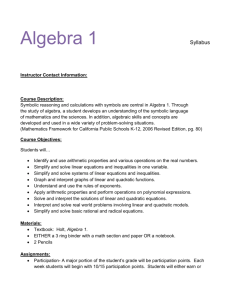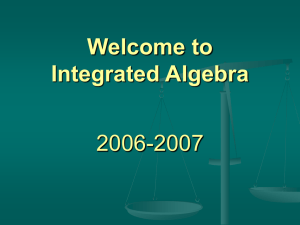Algebra II
advertisement

Algebra II Approved May 2011 1 Elements of Algebra Essential Understandings: 1. Mathematical models can be used to represent and understand quantitative relationships. Content Standards: 1. Understand and use algebraic skills and concepts. 2. Demonstrate number sense. Essential Questions: How do we classify numbers? How do we apply prior knowledge to new concepts? Learning Goals: Students will: Solve linear equations and identify solution sets for a given domain. Simplify radicals. Identify sets of numbers. Use the properties of exponents to simplify exponential expressions. Identify and understand the field axioms and their use in proof (A level) 2 Suggested Strategies Suggested Assessments Suggested Resources Suggested Tech Integration Lifelong Learning/21st Century Skills Collecting real world data relevant to the students interests and lives; using graphing calculators, DI according to student readiness Small group instruction quizzes unit test Text: Holt Algebra 1 (B & C Level); Prentice Hall Algebra 1 (A level) Supplemental handouts Internet sites: My.HRW.com (online companion website for Holt Algebra 1); purplemath.com Using the graphing calculator Productive habits of mind Quality work Read critically Communicate effectively Collaborate and cooperate Access and process information Core Ethical Values 3 Linear Functions and Relations Essential Understandings: 1. Mathematical models can be used to represent and understand quantitative relationships. Content Standards: 1. Understand and use patterns relationships and functions. 2. Understand and use algebraic skills and concepts. 3. Use a variety of strategies in the problem solving process. Essential Question: What are the real world applications of linear functions? Learning Goals: Students will: Identify and define relations and functions. Use function notation as it applies to linear functions. Graph linear equations and inequalities Determine how the intercepts of a function relate to the solution of a linear equation Determine the equation of a line and express the equation in various forms. Identify the domain and range of a linear function. Create mathematical models to solve real world problems. 4 Suggested Strategies Suggested Assessments Suggested Resources Suggested Tech Integration Content Vocabulary Lifelong Learning/21st Century Skills Provide real world applications relevant to student interests. Differentiate instruction according to student readiness. Small group and whole class instruction. Quizzes Unit Test Application Stations Text: Holt Algebra 2 (B and C Level); Prentice Hall Algebra 2 (A level); Algebra and Trigonometry: Functions and Applications (A level) Websites: http:\\my.hrw.com; purplemath.com;edhelper.com Using the graphing calculator Vertical line test Productive habits of mind Quality work Read critically Core Ethical Values 5 Systems of Equations and Inequalities Essential Understandings: 1. Mathematical models can be used to represent and understand quantitative relationships Content Standards: 1. Understand and use patterns relationships and functions. 2. Understand and use algebraic skills and concepts. 3. Use a variety of strategies in the problem solving process. Essential Question: How can we use systems to model and solve real world situations? Learning Goals: Students will: Solve a system of linear equations and inequalities in 2 and 3 variables using a variety of methods: graphing, algebraic substitution, linear combinations or matrices. Recognize consistent (independent) , inconsistent and dependent systems. Model and solve real world problems using systems of linear equations and inequalities Understand and apply basic properties of matrices. Use the addition, subtraction and scalar multiplication properties of matrices. Additional A level Learning Goals Compute determinants and inverses of matrices Perform the multiplication of matrices Solve matrix equations. Solve a non linear system of equations and inequalities using the graphing and algebraic substitution methods Graph linear equations in 3 space Determine the equation of a plane 6 Suggested Resources Suggested Tech Integration Content Vocabulary Suggested Strategies Suggested Assessments Lifelong Learning/21st Century Skills Provide real world applications relevant to student interests. Differentiate instruction according to student readiness. Small group and whole class instruction. Quizzes Unit Test Presentations Writing assignment: systems Text: Holt Algebra 2 (B and C Level); Prentice Hall Algebra 2 (A level); Algebra and Trigonometry: Functions and Applications (A level) Websites: http:\\my.hrw.com; purplemath.com;edhelper.com Using the graphing calculator Ordered triple, scalar, linear programming, matrix, determinant, trace, objective function, constraint, feasibility region Productive habits of mind Quality work Read critically Communicate effectively Collaborate and cooperate Core Ethical Values 7 Quadratics Essential Understandings: 1. Mathematical models can be used to represent and understand quantitative relationships Content Standards: 1. Understand and use patterns relationships and functions. 2. Understand and use algebraic skills and concepts. 3. Use a variety of strategies in the problem solving process. Essential Question: How are quadratic functions used to model and solve problems in the real world? Learning Goals: Students will: Graph quadratic functions. Solve quadratic equations using a variety of methods(factoring, quadratic formula, graphing, completing the square) Transform quadratic equations from standard to vertex form (and vice versa) Identify the important aspects of a quadratic function (vertex, axis of symmetry, y-intercept, zeros, maximum, minimum) Use the discriminant to determine the number and nature of roots. Fit a quadratic function to a set of data. Determine a quadratic function given the zeros of the function Recognize imaginary, complex numbers, and complex conjugates Perform operations (add, subtract, multiply and divide) with complex numbers. Solve and check quadratic equations that have imaginary roots Create quadratic models to solve real world problems. 8 Suggested Resources Suggested Tech Integration Content Vocabulary Suggested Strategies Suggested Assessments Lifelong Learning/21st Century Skills Provide real world applications relevant to student interests. Differentiate instruction according to student readiness. Small group and whole class instruction. Quizzes Unit Test Can roll lab, water fountain lab Text: Holt Algebra 2 (B and C Level); Prentice Hall Algebra 2 (A level); Algebra and Trigonometry: Functions and Applications (A level) Websites: http:\\my.hrw.com; purplemath.com;edhelper.com Using the graphing calculator, CBL’s, TI screen capture Axis of symmetry, vertex, complex number, discriminant, parabola, quadratic, zeros, vertex form, standard form, complex conjugate Productive habits of mind Quality work Read critically Communicate effectively Collaborate and cooperate Access and process information Core Ethical Values 9 Polynomial and Rational Functions Essential Understandings: 1. Mathematical models can be used to represent and understand quantitative relationships Content Standards: 1. Understand and use patterns relationships and functions. 2. Understand and use algebraic skills and concepts. Essential Question: How does the understanding of polynomial and rational functions and their solutions relate to real world applications? Learning Goals: Students will: Classify a polynomial function by number of terms and degree. Solve higher degree polynomial equations by factoring. Understand and apply the Fundamental Theorem of Algebra. Determine a polynomial function from given zeros. Determine vertical and horizontal asymptotes of a rational function Determine the existence and location of holes in a rational function. Solve rational equations. Model real world situations using polynomial and rational functions. Graph polynomial and rational functions. Simplify and perform operations on polynomial and rational expressions. Additional A Level Learning Goals Use long division or synthetic division to factor higher degree polynomials. Simplify and solve problems that involve complex fractions Identify the relative maximum and minimum from the graph of a polynomial function 10 Suggested Resources Suggested Tech Integration Content Vocabulary Suggested Strategies Suggested Assessments Lifelong Learning/21st Century Skills Provide real world applications relevant to student interests. Differentiate instruction according to student readiness. Small group and whole class instruction. Quizzes Unit Test Text: Holt Algebra 2 (B and C Level); Prentice Hall Algebra 2 (A level); Algebra and Trigonometry: Functions and Applications (A level) Websites: http:\\my.hrw.com; purplemath.com;edhelper.com; gcalc.net Using the graphing calculator Degree, monomial, binomial, trinomial, cubic, quartic, quintic, Fundamental Theorem of Algebra, synthetic division, relative minimum, relative maximum, asymptote, hole, discontinuity Productive habits of mind Quality work Core Ethical Values 11 Radicals and Related Functions Essential Understandings: 1. Mathematical models can be used to represent and understand quantitative relationships Content Standards: 1. Understand and use patterns relationships and functions. 2. Understand and use algebraic skills and concepts. Essential Questions: What is the real world application of an inverse function? Where do we use function composition in real life? Learning Goals: Students will: Add, subtract, multiply, divide, and simplify radical expressions Determine if a function is one-to-one. Determine the inverse of a one-to-one function. Perform operations (add, subtract, multiply and divide) with functions. Find the composite of two or more functions. Decompose a function into two or more functions. Solve radical equations. Graph radical functions and relations Determine if solutions are extraneous. Graph absolute value functions and state the vertex and axis of symmetry. 12 Suggested Strategies Suggested Assessments Suggested Resources Suggested Tech Integration Content Vocabulary Lifelong Learning/21st Century Skills Provide real world applications relevant to student interests. Differentiate instruction according to student readiness. Small group and whole class instruction. Ladder review activity Jigsaw activity Quizzes Unit Test Text: Holt Algebra 2 (B and C Level); Prentice Hall Algebra 2 (A level); Algebra and Trigonometry: Functions and Applications (A level) Websites: http:\\my.hrw.com; purplemath.com;edhelper.com; gcalc.net Using the graphing calculator Composite function, inverse, one-to-one, horizontal line test, extraneous Productive habits of mind Quality work Read critically Communicate effectively Collaborate and cooperate Core Ethical Values 13 Logarithmic and Exponential Functions Essential Understandings: 1. Mathematical models can be used to represent and understand quantitative relationships Content Standards: 1. Understand and use patterns relationships and functions. 2. Understand and use algebraic skills and concepts. 3. Use a variety of strategies in the problem solving process. Essential Question: What real world phenomena are modeled using exponential and logarithmic functions? Learning Goals: Students will: Recognize and understand the properties of exponential growth and decay Apply exponential growth and decay equations to solve real-world problems Apply the properties of exponents to positive, negative, zero and fractional exponents Understand the properties of logarithms, natural logarithms, and common logarithms Relate the inverse of an exponential function to its logarithmic function Use the properties of logarithms to expand and condense logarithmic expressions Solve logarithmic equations Apply logarithms to solve real world problems Graph exponential and logarithmic equations. 14 Suggested Strategies Suggested Assessments Suggested Resources Suggested Tech Integration Content Vocabulary Lifelong Learning/21st Century Skills Provide real world applications relevant to student interests. Differentiate instruction according to student readiness. Small group and whole class instruction. Video (measuring earthquakes and tsunamis) Quizzes Unit Test M&M lab Writing assignment (investigate real world applications of logs) Text: Holt Algebra 2 (B and C Level); Prentice Hall Algebra 2 (A level); Algebra and Trigonometry: Functions and Applications (A level) Websites: http:\\my.hrw.com; purplemath.com;edhelper.com; gcalc.net Using the graphing calculator Logarithm, decay, growth, natural log, common log, e Productive habits of mind Quality work Read critically Communicate effectively Collaborate and cooperate Access and process information Core Ethical Values 15 Analytic Geometry (A level) Essential Understandings: 1. Mathematical models can be used to represent and understand quantitative relationships Content Standards: 1. Understand and use spatial relationships and use basic concepts of geometry. 2. Understand and use patterns, relationships and functions. Essential Question: How is analytic geometry used to solve problems in the real world? Learning Goals: Students will: Write the standard equations of parabolas, ellipses and hyperbolas. Analyze and sketch graphs of parabolas, ellipses and hyperbolas. Use properties of conic sections to solve real life problems. 16 Suggested Strategies Suggested Assessments Suggested Resources Suggested Tech Integration Content Vocabulary Lifelong Learning/21st Century Skills Provide real world applications relevant to student interests. Differentiate instruction according to student readiness. Small group and whole class instruction. Graphic organizer Quizzes Unit Test Create image using conic sections Prentice Hall Algebra 2; Algebra and Trigonometry: Functions and Applications Websites: purplemath.com; edhelper.com; gcalc.net Using the graphing calculator Conic section, directrix, focus, foci, major axis, minor axis, eccentricity Productive habits of mind Quality work Read critically Collaborate and cooperate Core Ethical Values 17





